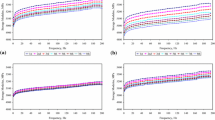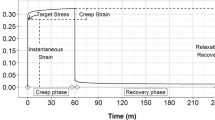Abstract
The effects of wet–dry and moist–dry cycling on the mechanical properties of reed (Arundo donax L.) were investigated. Because water-soluble extractives were lost through wetting, the reed shrunk in its tangential direction, and its dynamic Young’s modulus and loss tangent decreased during wet–dry cycling. On the other hand, the reed swelled in its radial direction because of the recovery of cell collapse, which had been induced by drying from a green state. Consequently, the resonant frequency of the reed monotonically increased during wet–dry cycling, whereas no clear trend was seen in bending rigidity. During moist–dry cycling, the equilibrium moisture content of reed decreased slightly. Such a reduction in hygroscopicity was attributed to the aggregation of deliquescent extractives. The changes in the dimensions and vibrational properties of the reed specimens during moist–dry cycling were qualitatively similar to those during wet–dry cycling. These results suggest that the practical performance of woodwind reed changes irreversibly during continuous usage.











Similar content being viewed by others
References
Bosshard HH (1974) Holzkunde Band 2 (Xylology Vol. 2). Birkhäuser Verlag, Switzerland, p 188 (in German)
Esteban LG, Gril J, de Palacios P, Casasús AG (2005) Reduction of wood hygroscopicity and associated dimensional response by repeated humidity cycles. Ann For Sci 62:275–284
French AP (1971) Vibrations and waves. WW Norton, New York, pp 92–96
Hunt DG, Balsan E (1996) Why old fiddles sound sweeter. Nature 379:681
Kohara J (1954) Studies on the performance of wood VI, the changes of mechanical properties of old timbers. Bull Kyoto Prefectur Univ 6:164–174 (in Japanese)
Mathlouthi M, Rogé B (2003) Water vapour sorption isotherms and the caking of food powders. Food Chem 82:61–71
Nakato K (1959) On the cause of the anisotropic shrinkage and swelling of wood XVII. On the anisotropic shrinkage of bamboo (1). Bull Kyoto Prefect Univ 11:95–104 (in Japanese)
Obataya E (1996a) The importance of reed quality for the clarinet players. Pipers 181:32–34 (in Japanese)
Obataya E (1996b) Physical properties of cane (Arundo donax) used for clarinet reed. Wood Res Technol Notes 32:30–65 (in Japanese)
Obataya E, Norimoto M (1995a) Acoustic properties of cane used for reeds of woodwind instruments I. Mokuzai Gakkaishi 41:289–292 (in Japanese)
Obataya E, Norimoto M (1995b) The water sorption isotherms of cane (Arundo donax L.) used for reeds of woodwind instruments. Mokuzai Gakkaishi 41:289–292 (in Japanese)
Obataya E, Norimoto M (1999) Acoustic properties of a reed (Arundo donax L.) used for the vibrating plate of a clarinet. J Acoust Soc Am 106(2):1106–1110
Obataya E, Umezawa T, Nakatsubo F, Norimoto M (1999) The effects of water soluble extractives on the acoustic properties of reed (Arundo donax L.). Holzforschung 5:63–67
Obataya E, Gril J, Thibaut B (2004) Shrinkage of cane (Arundo donax) I. Irregular shrinkage of green cane due to the collapse of parenchyma cells. J Wood Sci 50:295–300
Stein K (1958) The art of clarinet playing. Birch Tree Group, New Jersey, pp 6–9
Suzuki Y (1953) Studies on bamboo (IX) water relations of bamboo. Bull Univ Tokyo For 44:159–186
Author information
Authors and Affiliations
Corresponding author
Rights and permissions
About this article
Cite this article
Akahoshi, H., Obataya, E. Effects of wet–dry cycling on the mechanical properties of Arundo donax L. used for the vibrating reed in woodwind instruments. Wood Sci Technol 49, 1171–1183 (2015). https://doi.org/10.1007/s00226-015-0760-6
Received:
Published:
Issue Date:
DOI: https://doi.org/10.1007/s00226-015-0760-6




